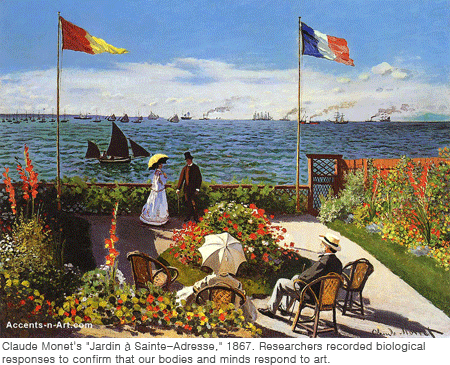Portraits Can Get Your Pulse Pounding
Art exhibits are not generally thought of as opportunities to get our pulses racing and skin tingling. But newly published research suggests aesthetic appreciation is, in fact, a full-body experience.
Three hundred and seventy-three visitors to a Swiss museum agreed to wear special gloves measuring four physiological responses as they strolled through an art exhibit. Researchers found an association between the gallery-goers’ reported responses to the artworks and three of the four measurements of bodily stimulation.
“Our findings suggest that an idiosyncratically human property — finding aesthetic pleasure in viewing artistic artifacts — is linked to biological markers,” researchers led by psychologist Wolfgang Tschacher of the University of Bern, Switzerland, write in the journal Psychology of Aesthetics, Creativity and the Arts.
Their study, the first of its kind conducted in an actual art gallery, provides evidence for what Tschacher and his colleagues call “the embodiment of aesthetics.”
The participants (65 percent were women) spent an average of 28 minutes viewing an exhibit at the Kunstmuseum St. Gallen in Switzerland. It featured 76 works of contemporary art, including paintings by Claude Monet, Edvard Munch, Andy Warhol and Paul Klee.
They wore a specially manufactured glove on their right hand, which measured four physiological responses: heart rate, heart rate variability, skin conductance level and skin conductance variability. According to the experts at MIT, skin conductance “is the phenomenon that the skin momentarily becomes a better conductor of electricity when either external or internal stimuli occur that are physiologically arousing.”
Researchers tracked participants as they strolled through the gallery, allowing them to record physiological reactions to specific artworks.
Afterward, each participant was asked his or her response to six of the pieces — the three they spent the most time viewing, as well as three others chosen in advance. At a computer terminal, they answered a 19-item questionnaire in which they described the emotions evoked by each of the pieces, as well as their aesthetic evaluation and general appraisal of the works.
Their answers were condensed into a set of five scores for each artwork: Aesthetic Quality (whether it was considered beautiful and well crafted in terms of technique and composition); Surprise/Humor (whether it startled the viewer or made him or her smile); Negative Emotion (whether it conveyed sadness, fear or anger); Dominance (whether it came across as powerful or stimulating); and Curative Quality (whether it worked well in the context of the other pieces).
Comparing these scores with the bodily responses, the researchers found three of the four physiological measurements — all except skin conductance — were “significantly associated with aesthetic-emotional assessments.”
Specifically, an elevated heart rate was linked to an assessment of a painting as dominant and/or high in curatorial quality. Heart-rate variability was linked to perceptions of high aesthetic quality and surprise/humor. Skin conductance variability was also linked to a perception of dominance.
“Heart-rate variability was the physiological measure most influenced by aesthetic emotional variables,” the researchers report. “Thirteen percent of total variance of HRV was accounted for by aesthetic-emotional-factors.”
Altogether, the participants’ reaction to the artworks accounted for “up to 25 percent of [their] total physiological variance,” they add.
Tschacher and his colleagues are quick to add that they do not interpret their results to mean that “aesthetic appreciation is nothing but a neurological response.” Nevertheless, their study provides real-time, on-site evidence that the mental/emotional act of art appreciation may be mirrored in the body.
Or — to take the approach of eminent brain researcher Antonio Damasio –perhaps the bodily reaction occurs first, after which our brain scrambles to come up with an explanation of why we responded in that way. Either way, when we say a work of art has stirred our heart, there’s a good chance it’s not simply a metaphor.
